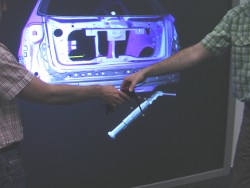Abstract

We investigated the utility of co-located collaborative interaction metaphors for assembly tasks in the automotive industry. In a first expert review, we compared the usability of a regular single-user stereoscopic system to a two-user system. Our experiments revealed that the two-user system greatly facilitates basic collaborative interactions, when users are standing next to each other. However, it is unsuitable for scenarios wherein users are facing each other and more sophisticated collaborative interactions are required. Our second study focused on these types of collaborative assembly tasks using head mounted displays instead of our projection-based setup. In a virtual assembly task, two workers had to mount the windshield of a car by using two different interaction methods. The first method employed tangible props and the other method relied solely on virtual interaction. Our evaluation shows that the multi-user prop-based interaction results in significantly higher accuracy and was clearly preferred by our users. These results are an important step towards the acceptance of such virtual techniques for reliable ergonomic evaluations of virtual assembly tasks.
Papers and Documents
Salzmann, H., Jacobs, J., Froehlich, B.
Collaborative Interaction in Co-Located Two-User Scenarios
In Proceedings of Joint Virtual Reality Conference (JVRC) - the 15th Eurographics Symposium on Virtual Environments, ICAT, EuroVR, Lyon, France, pp. 85-92, Dec. 2009.
[preprint]
